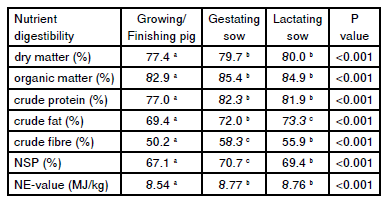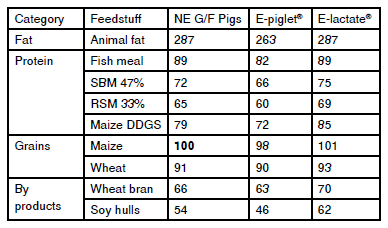The benefits to the Feed Industry of using an advanced net energy system
Published: May 29, 2014
By: Jannes Doppenberg, Ph. D. and Dr. Piet van der Aar, Schothorst Feed Research, The Netherlands
Summary
The Net Energy system offers the practical nutritionist the opportunity to adapt feed formulations to the varying chemical composition of feedstuffs when a NE-system based on nutrient (digestibility) is used. In general feed costs will be reduced by 1-2% by using a NE-system over a ME or DE system. Moreover an animal category specific NE system, specifying different E-piglet®, NE-growing/ finishing pigs, E-gestate® and E-lactate® system will offer additional benefits in terms of technical performance and reducing feed costs.
The Net Energy system offers several benefits to pork producer and the feed industry, mainly reducing the feed costs per kilogram of pork produced and a consistent technical performance when changing feed formulations due to changes in availability of feedstuffs and feedstuffs prices. In this article the use of an animal category specific Net Energy feedstuff table will be discussed based on the differences in physiological capacity between piglets, growing/finishing pigs, gestating and lactating sows to digest or ferment nutrients resulting in a different amount of Net Energy retained from feedstuffs differing in chemical composition. These feedstuff tables can therefore be used to formulate feeds meeting the nutritional requirements of specific animal categories and save feed costs when by-products are available for lower feedstuff prices. Since a usage of the Net Energy system will results in low protein, higher fibre and crude fat feed formulations the quality of the protein and fat sources used is more critical and continuous monitoring important.
Introduction
The chemical composition of feedstuffs can vary considerable resulting in different technical performances in practice. Moreover feedstuff prices and availability are dependent on local market conditions. For the practical nutritionist it is therefore of paramount importance to formulate feeds with a consistent and predictable performance while achieving the lowest costs possible. Therefore it is essential that with changing feedstuff prices and availability of feedstuffs, formulations can be adapted to the current market conditions and nutrient values of feedstuffs can be recalculated according to the chemical composition. A reliable, quick (NIR) analytical screening method in combination with a nutrient based feedstuff table and feed formulation system will provide the practical nutritionist with the tools to meet these challenges.
The Net Energy (NE) system is based on the ability for nutrients like protein, fat, starch, sugars or complex carbohydrates to be used for energy (ATP) production and (fat) deposition by the target animal. The Net Energy system differs from the Digestible Energy (DE) or Metabolisible Energy (ME) system that the metabolic efficiency by which energy derived from different nutrients has been taken in consideration. Resultantly the energy content of protein is decreased (due to the energy losses resulting from the excretion of excess nitrogen in the form of urea and the low metabolic efficiency for energy production of the remaining carbon fraction after de-ammonisation) and the energy derived from fat is increased (due to the high efficiency of which digested fat can be used metabolically for fat deposition or fat excretion (via milk fat). Consequently the use of a Net Energy system will result in lower crude protein levels in formulated feeds and a higher fat content. Resultantly low protein feeds will become more attractive, favoring the usage of highly digestible protein sources and synthetic amino acids. Formulating feed on a digestible (AID or SID) amino acid base to meet the essential amino acid requirements for different production goals is essential. Also low energy fibre rich, in general cheaper, feedstuffs will become more attractive in combination with an increased usage of fats & oils. Since by-products tend to be higher in contaminates like mycotoxins a practical approach to the maximum usage in formulated feeds for different animal categories (depending on the sensitive to different mycotoxins) and/or the usage of mycotoxin binders or detoxifiers needs to be made.
Diff erences in the NE -systems
The NE-system is based on the innovative research by Nehring and co-workers at Rostock and later introduced by Jean Noblet of the INRA. Via internet accessible programs like EvaPig, the NE as well as GE, DE or ME-value of feedstuffs can be calculated based on the chemical composition of feedstuffs and the underlying digestibility coefficients of the different nutrients. Various feedstuff tables like the Dutch CVB table are adapted on this original work. Recently the NRC table has also listed a NE-value of feedstuffs, however the NRC NE-system is a modified DE-system with an upgrade for the crude fat and starch content of feedstuffs and a downgrade for the crude protein content and fibre fractions rather than being a ‘true NE-system’ based on the metabolic usage of different nutrients. The general formula the NRC (2012) uses for complete feeds is: NE (kcal/kg) = 0.70*DE (kcal/kg) + 1.61 ether extract (g/kg) + 0.48 starch (g/kg) - 0.91 crude protein (g/kg) - 0.87 ADF (g/kg). While the CVB uses the nutrient based formula of: NE (MJ/kg DM) = 10.8 * digestible crude protein + 36.1 * digestible crude fat + 13.7 starch + 12.4 ileal digestible sugars + 9.6 fermentable carbohydrates. An important distinction is that the digestibility coefficients to be used in the CVB table are feedstuff dependent, based on digestibility experiments with the individual feedstuffs by growing/finishing pigs.
The determined digestible coefficients for the different nutrients depends largely on the parameters under which the digestibility experiments have been performed and therefore can differ considerable among different sources. It is essential that the digestibility experiments are performed under practical conditions (like feed intake level, feed processing and the age/physiological capacity of the animal to digest/ ferment nutrients) so that the results can be used for practical feed formulations. Moreover the nutrient requirements used for feed formulations should be obtained from performance trials based on the same feedstuff table, validating the effects of differences in nutrient digestibility of feedstuffs under practical conditions. In summary fixed feedstuff table values or not clearly defined nutrient requirements should not be used in feed formulations because the will result in inconsistent animal performance and/or increase feed costs.
Nutrient digestibility of formulated feeds and individual feedstuffs is dependent on the degree of feed processing (starch gelatinization and particle size reduction) as well as the feed intake level (due to the feed intake related endogenous losses). Digestibility experiments should therefore be conducted under standardized conditions in order to be able to study feedstuff effects and the effects of varying (chemical) composition on nutrient digestibility. Moreover the physiological capacity for different swine categories to digest and ferment nutrient is depending on the age and physiological maturity of the pig. Comparative digestion trials at Schothorst Feed Research have shown that:
- The crude protein and fat digestibility and fermentability of complex carbohydrates of piglets is considerable lower than that of growing/ finishing pigs (which were used as the reference animals) and feedstuff dependent. Resultantly the amount of Net Energy derived from feedstuffs by piglets is less than that by growing/ finishing pigs but also dependent on the chemical composition of the feedstuff.
- The crude protein and fat digestibility and fermentability of complex carbohydrates of (gestating and lactating) sows is significantly higher than that for growing/finishing pigs. Specifically the ability to ferment complex carbohydrates is age-dependent and increases with the physiological development of the gastro intestinal tract. The energy retained from low energy, high fibre by-products is therefore considerable higher. See Table 1. In this comparative digestion experiment the NE content of the same feed was 2.7% higher for sows than for growing/finishing pigs, mainly due to the higher fermentability of the NSP-fraction but also the fecal crude protein digestibility was 5.1 and the fat digestibility 3.3% higher.
Consequently different feedstuff tables should be used for different swine categories. This will result in practical feed formulation in:
- A higher nutritional and economical value and consequently usage of higher digestible feedstuffs like protein and fat sources in piglet feeds formulated with the E-piglet®. This will result in ‘safer’ feed formulations specifically if piglets feed have to be formulated without the usage of Anti-microbial Growth Promotors (AGP’s). Also the added value of higher digestible feedstuffs will be more elucidated in feed formulation.
- The usage of high or low fermentable by-products will be increased in feeds formulated with the E-gestate® or E-lacto®. This will not only result in decreasing feed costs but will have additional benefits like reducing embryonic death losses (increasing litter size), animal welfare, easy transition between gestating and lactating sow feeds.
- The ability to better adapt feed formulations to environmental conditions (summer and winter formulations to reduce the effects of heat stress or benefit from incremental heat production).
- Changing feed formulations according to the genetic feed intake capacity of the pigs or sows, resulting in optimising feed cost/ kg pork. Specifically for integrations or market where payment is based on the lean meat percentage controlling feed intake via the complex carbohydrate content of the feed is beneficial.
Table 1. Comparative nutrient digestibility of the same feed offered to growing/finishing pigs, gestating and lactating sows.


The relative differences in the NE-value of different classes of feedstuffs, compared to maize as the reference, with the NE determined with growing/finishing pigs, the E-piglet® and E-lactate® are outlined in Table 2. The E-piglet® value for all feedstuffs is lower than the NE value for growing/finishing pigs or lactating sows but considerable lower for animal fat and fibre rich feedstuffs like soy hulls and wheat bran. The E-lactate® value of protein and fibre rich feedstuffs like rapeseed meal and maize DDGS is increased significantly compared to the NE- value for growing/finishing pigs for protein sources like fish meal or soybean meal. Consequently in Least Cost Formulation the economical value (shadow price) and usage of feedstuffs will depend on the NE-system used and feed formulations can easily be adapted meeting the physiological capacity of animal to digest and ferment nutrients for the lowest cost possible.
Table 2. The relative differences in the NE growing/finishing pigs, the E-piglet® and E-lactate® value of different classes of feedstuffs, compared to maize as the reference ( = 100).

Authors:
Schothorst Feed Research
Schothorst Feed Research
Recommend
Comment
Share

Would you like to discuss another topic? Create a new post to engage with experts in the community.





